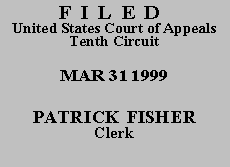

| JAMES R. GRIFFITH,
Plaintiff-Appellant, v. KENNETH S. APFEL, Commissioner, Social Security Administration, Defendant-Appellee. |
|
Claimant James R. Griffith appeals the district court's order(1) affirming the Commissioner's decision to deny his application for social security disability benefits. He alleges disability since August 1, 1989 due to back pain, diabetes, and foot pain and numbness. The parties agree that Mr. Griffith's insured status expired on September 30, 1994, so he must establish his disability prior to that date. See Miller v. Chater, 99 F.3d 972, 975 (10th Cir. 1996). Following an administrative hearing before an administrative law judge, the Commissioner determined at step five of the five-step analysis, see Williams v. Bowen, 844 F.2d 748, 750-52 (10th Cir. 1988) (discussing five steps), that Mr. Griffith could perform a full range of sedentary work and, therefore, he was not disabled within the meaning of the Social Security Act. On appeal, Mr. Griffith contends that (1) the ALJ did not evaluate properly his claims of disabling pain, (2) the ALJ improperly based his decision on a lack of medical evidence that Mr. Griffith was required to elevate his feet while sitting, (3) the ALJ failed to shift the burden to the Commissioner at step five, and (4) the ALJ considered medical reports written before Mr. Griffith's back surgery to discount his claims of disabling pain following the surgery.
We review the Commissioner's decision to determine whether it is supported by substantial evidence and whether correct legal standards were applied. See Hawkins v. Chater, 113 F.3d 1162, 1164 (10th Cir. 1997). Substantial evidence is "'such relevant evidence as a reasonable mind might accept as adequate to support a conclusion.'" Soliz v. Chater, 82 F.3d 373, 375 (10th Cir. 1996) (quoting Richardson v. Perales, 402 U.S. 389, 401 (1971) (further quotation omitted)). We may neither reweigh the evidence nor substitute our judgment for that of the Commissioner. See Casias v. Secretary of Health & Human Servs., 933 F.2d 799, 800 (10th Cir. 1991).
Mr. Griffith complains that the ALJ improperly discounted his claim that he must elevate his feet while sitting. He relies on a November 4, 1993 report by Dr. Denton. See Appellant's App. vol. II, at 162. Later reports by Dr. Malavolti, the treating podiatrist, however, do not indicate that Mr. Griffith must elevate his feet, only that he not do a job requiring him to stand for prolonged periods. See id. at 255-56. Mr. Griffith argues that the ALJ relied on a lack of evidence to reject his claim that he must elevate his feet based on the fact that Dr. Malavolti did not impose such a requirement. The treating podiatrist's failure to restrict Mr. Griffith's ability to sit is not a lack of evidence; rather, it indicates that the podiatrist imposed no limitations other than those specifically described. Based on our review of the record, we determine that the ALJ complied with the requirements of Kepler v. Chater, 68 F.3d 387, 391 (10th Cir. 1995), to consider the proper factors and adequately explain the reasons for discounting Mr. Griffith's claims that he must elevate his feet and alternate sitting and standing every forty-five minutes due to back and foot pain. See Appellant's App. vol. II, at 21-22.
Mr. Griffith also argues that the ALJ erred in finding him capable of performing a full range of sedentary work and in failing to recognize that at step five the burden shifts to the Commissioner to demonstrate that a claimant can perform other jobs that exist in sufficient numbers in the national economy. See Daniels v. Apfel, 154 F.3d 1129, 1132 (10th Cir. 1998). The ALJ clearly shifted the burden to the Commissioner. See Appellant's App. vol. II, at 23.
Mr. Griffith asserts that the ALJ relied on medical evidence from before his back surgery to discount his claim of disabling pain after the surgery. He maintains that only the back surgeon's opinions following his September 1994 surgery are relevant. Those opinions, however, indicate that Mr. Griffith's back pain subsided following the surgery, see Appellant's App. vol. II, at 179, and the ALJ considered those opinions, see id. at 21. The ALJ did not commit reversible error. The record contains substantial evidence to support the Commissioner's determination that Mr. Griffith was not disabled within the meaning of the Social Security Act prior to the expiration of his insured status.
The judgment of the United States District Court for the Northern District of Oklahoma is AFFIRMED.
Entered for the Court
Circuit Judge
*. This order and judgment is not binding precedent, except under the doctrines of law of the case, res judicata, and collateral estoppel. The court generally disfavors the citation of orders and judgments; nevertheless, an order and judgment may be cited under the terms and conditions of 10th Cir. R. 36.3.
1. The parties proceeded before a magistrate judge. See 28 U.S.C. § 636.